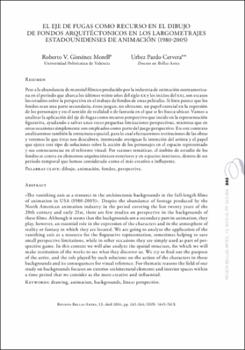El eje de fugas como recurso en el dibujo de fondos arquitectónicos en los largometrajes estadounidenses de animación (1980-2005)
Fecha
2016Resumen
Pese a la abundancia de material fílmico producido por la industria de animación norteamericana
en el período que abarca los últimos veinte años del siglo xx y los inicios del xxi, son escasos
los estudios sobre la perspectiva en el trabajo de fondos de estas películas. Si bien parece que los
fondos sean una parte secundaria, éstos juegan, no obstante, un papel esencial en la expresión
de los personajes y en el sentido de realidad o de fantasía en el que se les busca ubicar. Vamos a
analizar la aplicación del eje de fugas como recurso perspectivo que incide en la representación
figurativa, ayudando a salvar unas veces pequeñas limitaciones perspectivas, mientras que en
otras ocasiones simplemente son empleados como parte del juego perspectivo. En este contexto
analizaremos también la estructura espacial, para lo cual efectuaremos restituciones de las obras
y veremos lo que éstas nos descubren, intentando averiguar la intención del artista y el papel
que ejerce este tipo de soluciones sobre la acción de los personajes en el espacio representado
y sus consecuencias en el referente visual. Por razones temáticas, el ámbito de estudio de los
fondos se centra en elementos arquitectónicos exteriores y en espacios interiores, dentro de un
período temporal que hemos considerado como el más creativo e influyente. Despite the abundance of footage produced by the
North American animation industry in the period covering the last twenty years of the
20th century and early 21st, there are few studies on perspective in the backgrounds of
these films. Although it seems that the backgrounds are a secondary part in animation, they
play, however, an essential role in the expression of the characters and in the atmosphere of
reality or fantasy in which they are located. We are going to analyze the application of the
vanishing axis as a resource for the firgurative representation, sometimes helping to save
small perspective limitations, while in other occasions they are simply used as part of perspective
game. In this context we will also analyze the spatial structure, for which we will
make restitution of the works to see what they discover us. We try to find out the purpose
of the artist, and the role played by such solutions on the action of the characters in those
backgrounds and its consequences for visual reference. For thematic reasons the field of our
study on backgrounds focuses on exterior architectural elements and interior spaces within
a time period that we consider as the most creative and influential.





